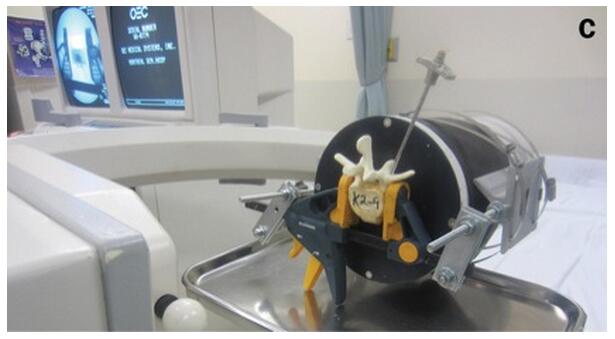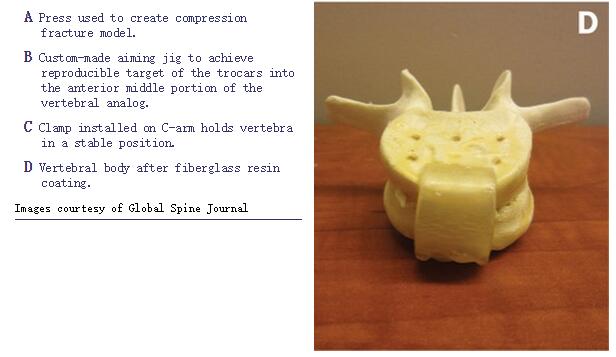Study Suggests Vertebroplasty Delivers More Cement Into Vertebrae Than Kyphoplasty
A larger volume of high-viscosity cement can be injected into vertebral analogs with simulated compression fractures before cement leakage with vertebroplasty than with kyphoplasty, suggests a new study.
Researchers used 40 artificial vertebral analogs made of polyurethane (Sawbones, Pacific Research Laboratories) as a model of osteoporotic L3 vertebrae with compression fracture.
The vertebrae were divided into groups of 10 and injected with the following: low-viscosity cement using vertebroplasty, high-viscosity cement using vertebroplasty, low-viscosity cement using balloon kyphoplasty and high-viscosity cement using balloon kyphoplasty. The researchers then calculated the volume of cement injected with both weight measurement and bone filler–device measurement.
The team, led by Fahad Abduljabbar, MBBS, surgery resident, McGill Scoliosis and Spine Centre, McGill University Health Centre, in Montreal, Canada, found that an average of 5.6 mL of high-viscosity cement could be injected with vertebroplasty before leakage; the next closest volume was 3.5 mL of high-viscosity cement injected via kyphoplasty. Low-viscosity cement injected lower volumes. The team also found that vertebroplasty filled the vertebral body more uniformly.
The researchers concluded that “vertebroplasty with high-viscosity cement is a good choice from the perspective of both cement leak safety and health care cost.”
Prior studies have shown that cement leakage can occur in up to 72% of procedures and is associated with potentially significant complications (Spine 2013;38[5]:E316-E318). The investigators also cited a meta-analysis that suggested vertebroplasty restores vertebral height (Eur Spine J 2012;21:1844-1859).
However, some experts like Shlomo Mandel, MD, who was not involved in the study, were not impressed with the findings. Dr. Mandel said this new study does not add any clinically relevant information to the field.



A Press used to create compression fracture model.
B Custom-made aiming jig to achieve reproducible target of the trocars into the anterior middle portion of the vertebral analog.
C Clamp installed on C-arm holds vertebra in a stable position.
D Vertebral body after fiberglass resin coating.
Images courtesy of Global Spine Journal
“What’s the difference how much cement is injected? The claim that the procedure restores vertebral bone height, regardless of injectable volume, is questionable at best,” said Dr. Mandel, clinical assistant professor at Wayne State University, in Chicago. “[Besides,] my personal and main reason for stopping K/V [kyphoplasty and vertebroplasty] is not the extravasation, but adjacent segment injury. I suspect more injection could result in greater incidence of adjacent fractures.”
Dr. Abduljabbar conceded that there is an increased risk for ad jacent-level fracture because of increased stiffness from cement injection.
“But if you weigh the risks, and based on the results in terms of pain reduction and improvement in spine-specific function and HRQoL [health-related quality of life], then these procedures are really beneficial,” Dr. Abduljabbar wrote in an email.
The study results were published in Global Spine Journal (2015 10.1055/s-0035-1546818) and were presented at the Canadian Spine Society 2015 annual meeting (abstract 52.1.4).
—Rosemary Frei, MSc





